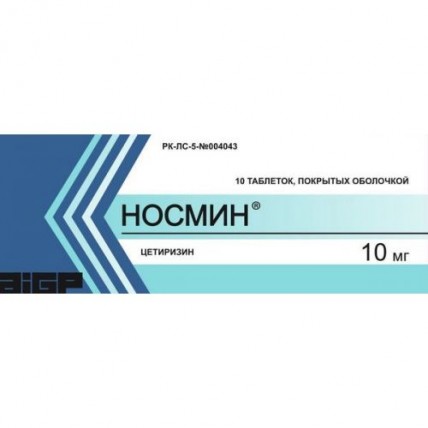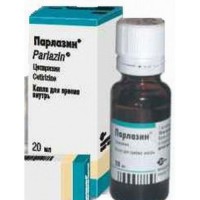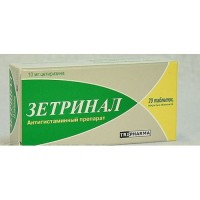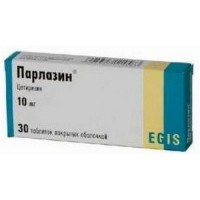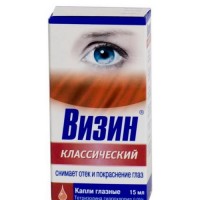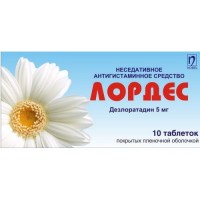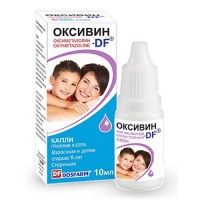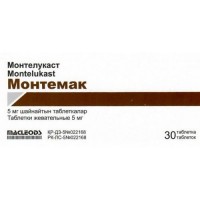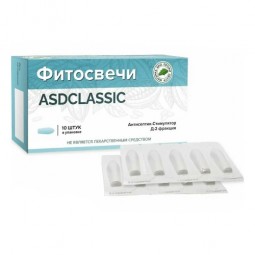Nosmin 10 mg (10 tablets)
- $5.70
Out Of Stock
The instruction for medical use of Nosmin® medicine the Trade name of Nosmin® the International unlicensed name Tsetirizin Lekarstvennaya the Tablet form, coated, 10 mg Structure One tablet contains active agent - a tsetirizin dihydrochloride of 10 mg, excipients: lactose monohydrate, cellulose microcrystalline, magnesium or calcium stearate, silicon dioxide colloidal anhydrous structure of a cover: polyethyleneglycol, a hydroksipropilmetiltsellyuloz, the titan dioxide (E 171) the Description of the Tablet round, biconvex, coated white color, with risky on one party and the engraved letter G on another. Pharmacotherapeutic group Antihistaminic drugs of systemic action. Piperazin derivatives. Tsetirizin. The ATX R06AE07 code the Pharmacological Pharmacokinetics Absorption Equilibrium Maximum Concentration properties in plasma makes about 300 ng/ml and is reached through 1.0 ± 0.5 h. Cumulation of a tsetirizin at the subsequent reception of a daily dose of 10 mg within 10 days is not observed. Distribution of pharmacokinetic parameters, such as plasma peak of concentration (Cmax) and area under curve (AUC), carries unimodal (only with one peak) character at volunteers. Extent of absorption of a tsetirizin does not decrease with meal though the speed of absorption decreases. Degree of bioavailability is similar when using a tsetirizin in the form of solution, capsules or tablets. The confirmed volume of distribution is 0.50 l/kg. Linking of a tsetirizin with proteins of plasma makes 93 ± 0.3%. Tsetirizin does not influence linking of warfarin with proteins. Tsetirizin is not exposed to intensive primary metabolism. About two thirds of a dose are removed in not changed view with urine. Final elimination half-life makes about 10 hours. Tsetirizin shows linear kinetics in the range from 5 to 60 mg. Features of reception in different populations Patients with renal failures At patients to a slight renal failure (the clearance of creatinine
& gt, 40 ml/min.) the pharmacokinetics of drug is similar to pharmacokinetics of healthy volunteers. In a moderate renal failure the elimination half-life increases by 3 times and the clearance decreases by 70% in comparison with normal volunteers. Patients on a hemodialysis (KK & lt, 7 ml/min.), at single dose of 10 mg of a tsetirizin observed 3-fold increase in elimination half-life and 70% decrease in clearance in comparison with healthy people. Tsetirizin badly leaves by means of a hemodialysis. In a moderate or heavy renal failure the dose adjustment is necessary. Patients with abnormal liver functions Patients with chronic diseases of a liver (hepatocellular, cholestatic and biliary cirrhosis) which applied 10 or 20 mg of a tsetirizin as a single dose observed 50% increase in elimination half-life and also 40% decrease in clearance in comparison with healthy people. Correction of a dose is necessary only for patients with the accompanying abnormal liver function and kidneys. Patients of advanced age After intake of a single dose of 10 mg, elimination half-life at 16 elderly patients in comparison with normal subjects increases approximately by 50%, and the clearance decreased by 40%. Decrease in absorption of a tsetirizin at elderly volunteers appeared, is connected with reduced function of kidneys. Pediatric population Elimination half-life of a tsetirizin makes about 6 hours at children from 6 to 12 years and 5 hours at children from 2 to 6 years. At children and babies from 6 to 24 months the elimination half-life decreases up to 3.1 h. The pharmacodynamics Tsetirizin, represents a human metabolite of Hydroxyzinum, the being potential and selection antagonist of peripheral H1 - histamine receptors. In experiments on linking with receptors in the conditions of in vitro the affinity of drug to other receptors, In addition to anti-H1 is not revealed - histamine to effect, tsetirizin shows the following antiallergic action: at reception in a dose of 10 mg one or twice a day, it inhibits an accumulation of eosinophils in later phase of allergic reaction, in skin and a conjunctiva at the persons suffering from an atopy after contact with allergens. Researches on healthy volunteers showed what tsetirizin in a dose of 5 and 10 mg strongly inhibits manifestations in the form of blisters and the active reactions caused by high concentrations of a histamine in skin, however the correlation with efficiency is not established. In a 35-day research at children from 5 to 12 years the tolerance to anti-histamine effect was not revealed (manifestations in the form of blisters and active symptoms). At the therapy termination the tsitiriziny ambassador of repeated reception, the normal reactivity of an integument to action of a histamine is restored within 3 days. In 6 weeks, placebo - a controlled research with participation of 186 patients with allergic rhinitis with the accompanying asthma easy or moderate severity, reception of 10 mg of a tsetirizin once in day improved symptoms of allergic rhinitis and had no damaging impact on functions of lungs. This research confirms safety of use of a tsetirizin for the allergized patients with asthma easy and moderate severity. In placebo - a controlled research tsetirizin it was appointed in the maximum dose of 60 mg a day within 7 days and did not cause statistically znachimovy lengthening of an interval of QT. Reception of a tsetirizin in the recommended dose showed improvement of quality of life of patients with year-round and seasonal allergic rhinitis. Indications For adults and children are more senior than 6 years - simplification of nasal and eye symptoms of seasonal and year-round allergic rhinitis - relief of symptoms of a chronic idiopathic small tortoiseshell the Route of administration and doses Children from 6 to 12 years On 5 mg (½ tablets) 2 times a day (twice a day). Adults and teenagers of 12 years are also more senior than 10 mg of 1 times a day (1 tablet). The initial dose of 5 mg (½ tablets) can lead to satisfactory control of symptoms. Tablets need to be swallowed, washing down with a glass of liquid. Duration of treatment is defined by the doctor. Elderly people the Data recommending a dose decline at elderly people with normal function of kidneys no. Patients with a moderate and heavy renal failure Data on ratio assessment advantage/risk at patients with impaired renal function are absent. As tsetirizin it is excreted mainly through kidneys, in case of lack of an alternative way of treatment, the interval of dosing has to be selected individually according to a condition of kidneys. In the table given below necessary changes of a dose are specified. For use of this table it is necessary estimate clearance of creatinine at the patient (KK) at ml/min. of KK (ml/min.) it can be estimated on the serum of creatinine (mg/dl) determined by the following formula: (140 – age of
× weight
) KK =-------------------------------------------------× (0.85 for women) 72 × creatinine of serum (mg/dl) Correction of a dose for adult patients with impaired renal function. A stage Removal of creatinine (ml/min.) the Dosage and frequency of use Norma ≥80 10 mg once, daily Weak 50-79 10 mg once, daily Moderate 30-49 5 mg once, daily Heavy ˂30 5 mg, every other day Patients, with a terminal renal failure, being on dialysis ˂10 are contraindicated For the children having a renal failure, the dose has to be picked up on an individual basis taking into account renal clearance of the patient, his age and body weight. The liver failure Dose adjustment is not required for patients with a liver failure. Pediatric population of the Tablet it is not necessary to apply at children 6 years as it is impossible to carry out the necessary selection dosed Children from 6 to 12 years are younger: 5 mg twice a day (on ½ tablets 2 times a day) Teenagers are more senior than 12 years: 10 mg once in day (1 tablet). At children with a renal failure the selection of a dose should be made on an individual basis, proceeding from renal clearance, age and weight. Side effects This clinical trials Tsetirizin in the recommended dosage shows the minimum influence on central nervous system, including drowsiness, fatigue, weakness, dizziness and a headache. Paradoxical stimulation of central nervous system was in certain cases noted. In spite of the fact that tsetirizin is selection inhibitor of peripheral H1-histamine receptors and has no anticholinergic activity, it was in some cases reported about the complicated urination, disturbance of accommodation of sight and dryness in a mouth. It was reported about cases of deviations as a liver with increase in level of liver enzymes, being followed by increase in level of bilirubin. Most often these symptoms disappeared after the treatment termination tsetiriziny dihydrochloride. List of by-effects: Quantitative data on safety of double blind controlled researches of comparison of a tsetirizin with placebo or other antihistaminic drugs in the recommended doses (10 mg in day of a tsetirizin), included over 3200 subjects receiving tsetirizin. From these data, about the following undesirable reactions it was reported at reception of 10 mg of a tsetirizin when carrying out placebo - controlled clinical trials at level from 1% and above. Undesirable reaction Tsetirizin (10 mg) (n=3260) of Placebo (n=3061) the General disorders and reactions in the injection site Fatigue of 1.63% of 0.95% of Disturbance from nervous system: Dizziness the Headache of 1.10% of 7.42% of 0.98% of 8.07% of Disturbance from digestive tract: Abdominal pains Dryness in a mouth Nausea of 0.98% of 2.09% of 1.07% of 1.08% of 0.82% of 1.14% Mental disorders: Drowsiness of 9.63% of 5.00% of Disturbance from respiratory bodies: Pharyngitis of 1.29% of 1.34% In spite of the fact that statistically more often drowsiness developed at reception of a tsetirizin, than placebo, the majority of cases was from easy to moderate severity. Objective tests of other researches showed that the usual daily activity was not broken at reception in the recommended doses at healthy volunteers. Pediatric population Undesirable reactions with a frequency from 1% and more children have from 6 to 12 years, including placebo - controlled researches, were the following: Undesirable reaction Tsetirizin (10 mg) (n=1656) of Placebo (n=1294) of Disturbance from digestive tract: Diarrhea of 1.0% of 0.6% Mental disorders: Drowsiness of 1.8% of 1.4% of Disturbance from respiratory bodies: Rhinitis of 1.4% of 1.1% the General disorders and reactions in the injection site Fatigue of 1.0% of 0.3% Post-marketing experience In addition to cases of the undesirable phenomena observed during conduct of clinical trials about the following cases of the undesirable phenomena it was reported on time of the post-marketing period. Frequency of development of the undesirable phenomena is defined as follows: Very often (≥1/10), it is frequent (≥1/100 to & lt, 1/10), Infrequently (≥1/1.000 to & lt, 1/100), is rare (from ≥1/10.000 to & lt, 1/1.000), Is very rare (& lt, 1/10.000), It is unknown (it is impossible to carry out the frequency assessment on the basis of the available data). From the haematogenic and lymphatic systems: Very seldom (& lt, 1/10.000): - thrombocytopenia from the immune system: Seldom (from ≥1/10.000 to & lt, 1/1.000): - hypersensitivity Very seldom (& lt, 1/10.000): - anaphylactic shock Metabolic disorders: It is unknown (it is impossible to carry out the frequency assessment on the basis of the available data): - increase in appetite Mental disturbances: Infrequently (≥1/1.000 to & lt, 1/100): - agitation Seldom (from ≥1/10.000 to & lt, 1/1.000): - aggression - confusion of consciousness - a depression - hallucinations - insomnia Very seldom (& lt, 1/10.000): - tics It is unknown (it is impossible to carry out the frequency assessment on the basis of the available data): - suicide thoughts from nervous system: Infrequently (≥1/1.000 to & lt, 1/100): - paresthesias it is rare (from ≥1/10.000 to & lt, 1/1.000): - convulsions It is very rare (& lt, 1/10.000): - a dysgeusia - a faint - a tremor - dystonia - dyskinesia It is unknown (it is impossible to carry out the frequency assessment on the basis of the available data): - amnesia - disturbances of memory from the visual device: Very seldom (& lt, 1/10.000): - accommodation disorder from a vestibular mechanism: It is unknown (it is impossible to carry out the frequency assessment on the basis of the available data): - vertigo from a cardiovascular system: Seldom (from ≥1/10.000 to & lt, 1/1.000): - tachycardia from digestive tract: It is unknown (it is impossible to carry out the frequency assessment on the basis of the available data): - diarrhea from a gepatobiliarny system: Seldom (from ≥1/10.000 to & lt, 1/1.000): - deviations of functions of a liver (povyshny the level of transaminases, alkaline phosphatase, γ-GT and bilirubin) from integuments: Infrequently (≥1/1.000 to & lt, 1/100): - an itching - rash Seldom (from ≥1/10.000 to & lt, 1/1.000): - urticaria Very seldom (& lt, 1/10.000): - a Quincke's disease - a toksikodermiya of Disorder of a secretory system: Very seldom (& lt, 1/10.000): - a dysuria - enuresis It is unknown (it is impossible to carry out the frequency assessment on the basis of the available data): - urination delay General disorders: Infrequently (≥1/1.000 to & lt, 1/100): - an asthenia - the indisposition Is rare (from ≥1/10.000 to & lt, 1/1.000): - swell From clinical observation: Seldom (from ≥1/10.000 to & lt, 1/1.000): - increase in weight of the Contraindication - hypersensitivity to active component or any component of drug and also to a hydrazine or any derivatives of piperazin, - patients with a heavy renal failure with clearance of creatinine less than 10 ml/min., - children's age up to 6 years Medicinal interactions In view of pharmacokinetic, pharmakodinamichesky parameters and a profile of shipping of a tsetirizin, interactions with this antihistaminic drug is not supposed. At the moment neither about pharmakodinamichesky, nor about significant pharmacokinetic interactions it was not reported in interaction researches drug-drug, especially with pseudoephedrine or theophylline (400mg/put). Extent of absorption of a tsetirizin does not decrease with meal in spite of the fact that the speed of absorption decreases. Sensitive patients have an accompanying use of alcohol or other drugs suppressing activity of central nervous system can lead to decrease in concentration and attention in spite of the fact that tsetirizin does not exponentiate effect of alcohol (0.5 g/l). Special instructions In therapeutic doses clinically significant interaction with alcohol is not revealed (on the blood alcohol level of 0.5 g/l). Nevertheless, it is recommended to observe precautionary measures if alcohol is accepted along with drug. Special attention is recommended to be paid to patients with the contributing ischuria factors (for example, injury of a spinal cord, a prostate hyperplasia) as tsetirizin can increase risk of an ischuria. It is necessary to be careful at use for patients with epilepsy and to patients with risk of developing spasms. Skin allergy tests are shown in a slowed-up way at intake of antihistamines in this connection keeping of the period of washing away (3 days) before conducting tests is required. Patients with rare hereditary intolerance of a galactose, a lactose intolerance of Lapp or glucosic galaktoznoy malabsorption are not recommended to take a pill of a tsetirizin, coated. Use for pediatric population Use of a tsetirizin in the form of tablets, coated, is not recommended at children 6 years in connection with impossibility of selection corresponding the dosed pregnancy Period Prospective collected data on use of a tsetirizin at pregnancy are younger do not assume toxicity for mother or for an embryo/fruit at reception in the doses exceeding therapeutic. Researches on animals did not show a direct or indirect adverse effect on a pregnancy course, development of an embryo/fruit, patrimonial process or post-natal development. However, it is necessary to be careful at use for pregnant women. The lactation period Tsetirizin is allocated in human milk in the concentration varying from 25% to 90% from contained in blood plasma, depending on sampling time after introduction. Therefore, the feeding women need to be careful when assigning a tsetirizin. Fertility Data on influence on fertility at the person are absent, however reasons for concern about safety of reception were not. The data obtained on animals show lack of the reasons for bespok
ystvo concerning influence on reproductive functions at the person. Features of influence of medicine on ability to run the vehicle or potentially dangerous mechanisms Objective measurements of ability to driving, the hidden drowsiness and ability to control of mechanisms did not show clinically significant deviations at reception in the recommended dose of 10 mg. Patients who need to be engaged in potentially dangerous types of activity or to work with the equipment, should not exceed the recommended doses and take reaction to medicine into account. Overdose Symptoms Observed symptoms after overdose of a tsetirizin, are generally connected with disturbances from central nervous system or with effects which presence assumes manifestation of anticholinergic effect. The undesirable phenomena revealed after reception of the dose exceeded, at least, by 5 times from the recommended day dose: confusion of consciousness, diarrhea, dizziness, fatigue, headache, indisposition, expansion of pupils, naggers, concern, sedation, drowsiness, stupor, tachycardia, tremor and ischuria. Treatment does not exist the known specific antidotes for a tsetirizin. At overdose the symptomatic or maintenance therapy is recommended. Gastric lavage should be made at once at emergence of collateral symptoms. Removal of a tsetirizin by means of dialysis is inefficient. The form of release and packing On 10 tablets place in blister strip packaging from a film of the polyvinylchloride and printing aluminum foil varnished. On 1 blister strip packaging together with the instruction for medical use in the state and Russian languages place in a pack from cardboard. Storage conditions In the dry, protected from light place at a temperature not over 25 of 0C. 3 years not to apply a period of storage after an expiration date! Prescription status According to the prescription Abdi Ibrahim Global Pharm LLP Producer, the Republic of Kazakhstan, the Almaty Region, the Iliysky area, Industrial zone 282, ph.: +7 (727) 232-44-85 The owner of the Registration certificate of Abdi Ibrahim Global Pharm LLP the Republic of Kazakhstan the Address of the organization accepting in the territory of the Republic of Kazakhstan claims from consumers on quality of products and responsible for post-registration observation of safety of medicine in the territory of the Republic of Kazakhstan Abdi Ibrahim Global Pharm LLP, the Republic of Kazakhstan, the Almaty Region, the Iliysky area, Industrial zone 282, ph.: +7 (727) 232-44-85, the e-mail address:
To Develop info@aigp.kz
& gt, 40 ml/min.) the pharmacokinetics of drug is similar to pharmacokinetics of healthy volunteers. In a moderate renal failure the elimination half-life increases by 3 times and the clearance decreases by 70% in comparison with normal volunteers. Patients on a hemodialysis (KK & lt, 7 ml/min.), at single dose of 10 mg of a tsetirizin observed 3-fold increase in elimination half-life and 70% decrease in clearance in comparison with healthy people. Tsetirizin badly leaves by means of a hemodialysis. In a moderate or heavy renal failure the dose adjustment is necessary. Patients with abnormal liver functions Patients with chronic diseases of a liver (hepatocellular, cholestatic and biliary cirrhosis) which applied 10 or 20 mg of a tsetirizin as a single dose observed 50% increase in elimination half-life and also 40% decrease in clearance in comparison with healthy people. Correction of a dose is necessary only for patients with the accompanying abnormal liver function and kidneys. Patients of advanced age After intake of a single dose of 10 mg, elimination half-life at 16 elderly patients in comparison with normal subjects increases approximately by 50%, and the clearance decreased by 40%. Decrease in absorption of a tsetirizin at elderly volunteers appeared, is connected with reduced function of kidneys. Pediatric population Elimination half-life of a tsetirizin makes about 6 hours at children from 6 to 12 years and 5 hours at children from 2 to 6 years. At children and babies from 6 to 24 months the elimination half-life decreases up to 3.1 h. The pharmacodynamics Tsetirizin, represents a human metabolite of Hydroxyzinum, the being potential and selection antagonist of peripheral H1 - histamine receptors. In experiments on linking with receptors in the conditions of in vitro the affinity of drug to other receptors, In addition to anti-H1 is not revealed - histamine to effect, tsetirizin shows the following antiallergic action: at reception in a dose of 10 mg one or twice a day, it inhibits an accumulation of eosinophils in later phase of allergic reaction, in skin and a conjunctiva at the persons suffering from an atopy after contact with allergens. Researches on healthy volunteers showed what tsetirizin in a dose of 5 and 10 mg strongly inhibits manifestations in the form of blisters and the active reactions caused by high concentrations of a histamine in skin, however the correlation with efficiency is not established. In a 35-day research at children from 5 to 12 years the tolerance to anti-histamine effect was not revealed (manifestations in the form of blisters and active symptoms). At the therapy termination the tsitiriziny ambassador of repeated reception, the normal reactivity of an integument to action of a histamine is restored within 3 days. In 6 weeks, placebo - a controlled research with participation of 186 patients with allergic rhinitis with the accompanying asthma easy or moderate severity, reception of 10 mg of a tsetirizin once in day improved symptoms of allergic rhinitis and had no damaging impact on functions of lungs. This research confirms safety of use of a tsetirizin for the allergized patients with asthma easy and moderate severity. In placebo - a controlled research tsetirizin it was appointed in the maximum dose of 60 mg a day within 7 days and did not cause statistically znachimovy lengthening of an interval of QT. Reception of a tsetirizin in the recommended dose showed improvement of quality of life of patients with year-round and seasonal allergic rhinitis. Indications For adults and children are more senior than 6 years - simplification of nasal and eye symptoms of seasonal and year-round allergic rhinitis - relief of symptoms of a chronic idiopathic small tortoiseshell the Route of administration and doses Children from 6 to 12 years On 5 mg (½ tablets) 2 times a day (twice a day). Adults and teenagers of 12 years are also more senior than 10 mg of 1 times a day (1 tablet). The initial dose of 5 mg (½ tablets) can lead to satisfactory control of symptoms. Tablets need to be swallowed, washing down with a glass of liquid. Duration of treatment is defined by the doctor. Elderly people the Data recommending a dose decline at elderly people with normal function of kidneys no. Patients with a moderate and heavy renal failure Data on ratio assessment advantage/risk at patients with impaired renal function are absent. As tsetirizin it is excreted mainly through kidneys, in case of lack of an alternative way of treatment, the interval of dosing has to be selected individually according to a condition of kidneys. In the table given below necessary changes of a dose are specified. For use of this table it is necessary estimate clearance of creatinine at the patient (KK) at ml/min. of KK (ml/min.) it can be estimated on the serum of creatinine (mg/dl) determined by the following formula: (140 – age of
× weight
) KK =-------------------------------------------------× (0.85 for women) 72 × creatinine of serum (mg/dl) Correction of a dose for adult patients with impaired renal function. A stage Removal of creatinine (ml/min.) the Dosage and frequency of use Norma ≥80 10 mg once, daily Weak 50-79 10 mg once, daily Moderate 30-49 5 mg once, daily Heavy ˂30 5 mg, every other day Patients, with a terminal renal failure, being on dialysis ˂10 are contraindicated For the children having a renal failure, the dose has to be picked up on an individual basis taking into account renal clearance of the patient, his age and body weight. The liver failure Dose adjustment is not required for patients with a liver failure. Pediatric population of the Tablet it is not necessary to apply at children 6 years as it is impossible to carry out the necessary selection dosed Children from 6 to 12 years are younger: 5 mg twice a day (on ½ tablets 2 times a day) Teenagers are more senior than 12 years: 10 mg once in day (1 tablet). At children with a renal failure the selection of a dose should be made on an individual basis, proceeding from renal clearance, age and weight. Side effects This clinical trials Tsetirizin in the recommended dosage shows the minimum influence on central nervous system, including drowsiness, fatigue, weakness, dizziness and a headache. Paradoxical stimulation of central nervous system was in certain cases noted. In spite of the fact that tsetirizin is selection inhibitor of peripheral H1-histamine receptors and has no anticholinergic activity, it was in some cases reported about the complicated urination, disturbance of accommodation of sight and dryness in a mouth. It was reported about cases of deviations as a liver with increase in level of liver enzymes, being followed by increase in level of bilirubin. Most often these symptoms disappeared after the treatment termination tsetiriziny dihydrochloride. List of by-effects: Quantitative data on safety of double blind controlled researches of comparison of a tsetirizin with placebo or other antihistaminic drugs in the recommended doses (10 mg in day of a tsetirizin), included over 3200 subjects receiving tsetirizin. From these data, about the following undesirable reactions it was reported at reception of 10 mg of a tsetirizin when carrying out placebo - controlled clinical trials at level from 1% and above. Undesirable reaction Tsetirizin (10 mg) (n=3260) of Placebo (n=3061) the General disorders and reactions in the injection site Fatigue of 1.63% of 0.95% of Disturbance from nervous system: Dizziness the Headache of 1.10% of 7.42% of 0.98% of 8.07% of Disturbance from digestive tract: Abdominal pains Dryness in a mouth Nausea of 0.98% of 2.09% of 1.07% of 1.08% of 0.82% of 1.14% Mental disorders: Drowsiness of 9.63% of 5.00% of Disturbance from respiratory bodies: Pharyngitis of 1.29% of 1.34% In spite of the fact that statistically more often drowsiness developed at reception of a tsetirizin, than placebo, the majority of cases was from easy to moderate severity. Objective tests of other researches showed that the usual daily activity was not broken at reception in the recommended doses at healthy volunteers. Pediatric population Undesirable reactions with a frequency from 1% and more children have from 6 to 12 years, including placebo - controlled researches, were the following: Undesirable reaction Tsetirizin (10 mg) (n=1656) of Placebo (n=1294) of Disturbance from digestive tract: Diarrhea of 1.0% of 0.6% Mental disorders: Drowsiness of 1.8% of 1.4% of Disturbance from respiratory bodies: Rhinitis of 1.4% of 1.1% the General disorders and reactions in the injection site Fatigue of 1.0% of 0.3% Post-marketing experience In addition to cases of the undesirable phenomena observed during conduct of clinical trials about the following cases of the undesirable phenomena it was reported on time of the post-marketing period. Frequency of development of the undesirable phenomena is defined as follows: Very often (≥1/10), it is frequent (≥1/100 to & lt, 1/10), Infrequently (≥1/1.000 to & lt, 1/100), is rare (from ≥1/10.000 to & lt, 1/1.000), Is very rare (& lt, 1/10.000), It is unknown (it is impossible to carry out the frequency assessment on the basis of the available data). From the haematogenic and lymphatic systems: Very seldom (& lt, 1/10.000): - thrombocytopenia from the immune system: Seldom (from ≥1/10.000 to & lt, 1/1.000): - hypersensitivity Very seldom (& lt, 1/10.000): - anaphylactic shock Metabolic disorders: It is unknown (it is impossible to carry out the frequency assessment on the basis of the available data): - increase in appetite Mental disturbances: Infrequently (≥1/1.000 to & lt, 1/100): - agitation Seldom (from ≥1/10.000 to & lt, 1/1.000): - aggression - confusion of consciousness - a depression - hallucinations - insomnia Very seldom (& lt, 1/10.000): - tics It is unknown (it is impossible to carry out the frequency assessment on the basis of the available data): - suicide thoughts from nervous system: Infrequently (≥1/1.000 to & lt, 1/100): - paresthesias it is rare (from ≥1/10.000 to & lt, 1/1.000): - convulsions It is very rare (& lt, 1/10.000): - a dysgeusia - a faint - a tremor - dystonia - dyskinesia It is unknown (it is impossible to carry out the frequency assessment on the basis of the available data): - amnesia - disturbances of memory from the visual device: Very seldom (& lt, 1/10.000): - accommodation disorder from a vestibular mechanism: It is unknown (it is impossible to carry out the frequency assessment on the basis of the available data): - vertigo from a cardiovascular system: Seldom (from ≥1/10.000 to & lt, 1/1.000): - tachycardia from digestive tract: It is unknown (it is impossible to carry out the frequency assessment on the basis of the available data): - diarrhea from a gepatobiliarny system: Seldom (from ≥1/10.000 to & lt, 1/1.000): - deviations of functions of a liver (povyshny the level of transaminases, alkaline phosphatase, γ-GT and bilirubin) from integuments: Infrequently (≥1/1.000 to & lt, 1/100): - an itching - rash Seldom (from ≥1/10.000 to & lt, 1/1.000): - urticaria Very seldom (& lt, 1/10.000): - a Quincke's disease - a toksikodermiya of Disorder of a secretory system: Very seldom (& lt, 1/10.000): - a dysuria - enuresis It is unknown (it is impossible to carry out the frequency assessment on the basis of the available data): - urination delay General disorders: Infrequently (≥1/1.000 to & lt, 1/100): - an asthenia - the indisposition Is rare (from ≥1/10.000 to & lt, 1/1.000): - swell From clinical observation: Seldom (from ≥1/10.000 to & lt, 1/1.000): - increase in weight of the Contraindication - hypersensitivity to active component or any component of drug and also to a hydrazine or any derivatives of piperazin, - patients with a heavy renal failure with clearance of creatinine less than 10 ml/min., - children's age up to 6 years Medicinal interactions In view of pharmacokinetic, pharmakodinamichesky parameters and a profile of shipping of a tsetirizin, interactions with this antihistaminic drug is not supposed. At the moment neither about pharmakodinamichesky, nor about significant pharmacokinetic interactions it was not reported in interaction researches drug-drug, especially with pseudoephedrine or theophylline (400mg/put). Extent of absorption of a tsetirizin does not decrease with meal in spite of the fact that the speed of absorption decreases. Sensitive patients have an accompanying use of alcohol or other drugs suppressing activity of central nervous system can lead to decrease in concentration and attention in spite of the fact that tsetirizin does not exponentiate effect of alcohol (0.5 g/l). Special instructions In therapeutic doses clinically significant interaction with alcohol is not revealed (on the blood alcohol level of 0.5 g/l). Nevertheless, it is recommended to observe precautionary measures if alcohol is accepted along with drug. Special attention is recommended to be paid to patients with the contributing ischuria factors (for example, injury of a spinal cord, a prostate hyperplasia) as tsetirizin can increase risk of an ischuria. It is necessary to be careful at use for patients with epilepsy and to patients with risk of developing spasms. Skin allergy tests are shown in a slowed-up way at intake of antihistamines in this connection keeping of the period of washing away (3 days) before conducting tests is required. Patients with rare hereditary intolerance of a galactose, a lactose intolerance of Lapp or glucosic galaktoznoy malabsorption are not recommended to take a pill of a tsetirizin, coated. Use for pediatric population Use of a tsetirizin in the form of tablets, coated, is not recommended at children 6 years in connection with impossibility of selection corresponding the dosed pregnancy Period Prospective collected data on use of a tsetirizin at pregnancy are younger do not assume toxicity for mother or for an embryo/fruit at reception in the doses exceeding therapeutic. Researches on animals did not show a direct or indirect adverse effect on a pregnancy course, development of an embryo/fruit, patrimonial process or post-natal development. However, it is necessary to be careful at use for pregnant women. The lactation period Tsetirizin is allocated in human milk in the concentration varying from 25% to 90% from contained in blood plasma, depending on sampling time after introduction. Therefore, the feeding women need to be careful when assigning a tsetirizin. Fertility Data on influence on fertility at the person are absent, however reasons for concern about safety of reception were not. The data obtained on animals show lack of the reasons for bespok
ystvo concerning influence on reproductive functions at the person. Features of influence of medicine on ability to run the vehicle or potentially dangerous mechanisms Objective measurements of ability to driving, the hidden drowsiness and ability to control of mechanisms did not show clinically significant deviations at reception in the recommended dose of 10 mg. Patients who need to be engaged in potentially dangerous types of activity or to work with the equipment, should not exceed the recommended doses and take reaction to medicine into account. Overdose Symptoms Observed symptoms after overdose of a tsetirizin, are generally connected with disturbances from central nervous system or with effects which presence assumes manifestation of anticholinergic effect. The undesirable phenomena revealed after reception of the dose exceeded, at least, by 5 times from the recommended day dose: confusion of consciousness, diarrhea, dizziness, fatigue, headache, indisposition, expansion of pupils, naggers, concern, sedation, drowsiness, stupor, tachycardia, tremor and ischuria. Treatment does not exist the known specific antidotes for a tsetirizin. At overdose the symptomatic or maintenance therapy is recommended. Gastric lavage should be made at once at emergence of collateral symptoms. Removal of a tsetirizin by means of dialysis is inefficient. The form of release and packing On 10 tablets place in blister strip packaging from a film of the polyvinylchloride and printing aluminum foil varnished. On 1 blister strip packaging together with the instruction for medical use in the state and Russian languages place in a pack from cardboard. Storage conditions In the dry, protected from light place at a temperature not over 25 of 0C. 3 years not to apply a period of storage after an expiration date! Prescription status According to the prescription Abdi Ibrahim Global Pharm LLP Producer, the Republic of Kazakhstan, the Almaty Region, the Iliysky area, Industrial zone 282, ph.: +7 (727) 232-44-85 The owner of the Registration certificate of Abdi Ibrahim Global Pharm LLP the Republic of Kazakhstan the Address of the organization accepting in the territory of the Republic of Kazakhstan claims from consumers on quality of products and responsible for post-registration observation of safety of medicine in the territory of the Republic of Kazakhstan Abdi Ibrahim Global Pharm LLP, the Republic of Kazakhstan, the Almaty Region, the Iliysky area, Industrial zone 282, ph.: +7 (727) 232-44-85, the e-mail address:
To Develop info@aigp.kz
